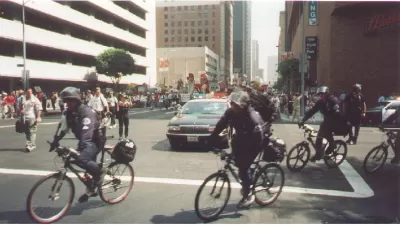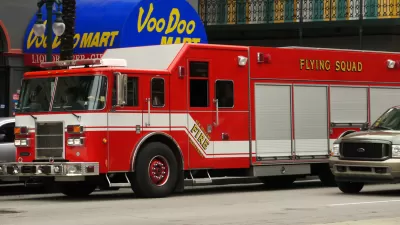The 'Vision Zero' movement to eliminate pedestrian deaths is fantastic. It is helping cities around the world create better, safer streets. The name and its embrace of absolutes dooms cities to failure.
The "Vision Zero" movement is influencing planners around the world, encouraging them to give greater advantage to humans in the century-old battle between pedestrians and cars. A dozen cities in the United States, including Los Angeles, San Diego, and San Francisco, have adopted its principles. The principles are admirable, writes Josh Stephens in the California Planning & Development Report. The name, though, is antithetical to how planning actually works.
"Accidents are going to happen, even in Copenhagen. Someone is going to bust an inner tube and hit the curb. Someone is going to slip on a carelessly discarded smørrebrød. Someone will get tangled in his scarf and end up in a canal. Even perfect cities aren't perfect."
"The fact is, planning can never eliminate all bad things -- whatever the thing happens to be. In the case of pedestrian safety, it can absolutely reduce deaths. It can, if you go back to high school calculus, approach zero. But this is still a free country. Unless Los Angeles bans cars entirely and replaces all its pavement with compacted marshmallow, it can never reach zero. Not in 2015, not in 2035, not ever. In the battle between absolutes and public policy, policy never wins."
FULL STORY: A Plan with 'Zero' Chance of Success

Planetizen Federal Action Tracker
A weekly monitor of how Trump’s orders and actions are impacting planners and planning in America.

Congressman Proposes Bill to Rename DC Metro “Trump Train”
The Make Autorail Great Again Act would withhold federal funding to the system until the Washington Metropolitan Area Transit Authority (WMATA), rebrands as the Washington Metropolitan Authority for Greater Access (WMAGA).

The Simple Legislative Tool Transforming Vacant Downtowns
In California, Michigan and Georgia, an easy win is bringing dollars — and delight — back to city centers.

The States Losing Rural Delivery Rooms at an Alarming Pace
In some states, as few as 9% of rural hospitals still deliver babies. As a result, rising pre-term births, no adequate pre-term care and "harrowing" close calls are a growing reality.

The Small South Asian Republic Going all in on EVs
Thanks to one simple policy change less than five years ago, 65% of new cars in this Himalayan country are now electric.

DC Backpedals on Bike Lane Protection, Swaps Barriers for Paint
Citing aesthetic concerns, the city is removing the concrete barriers and flexposts that once separated Arizona Avenue cyclists from motor vehicles.
Urban Design for Planners 1: Software Tools
This six-course series explores essential urban design concepts using open source software and equips planners with the tools they need to participate fully in the urban design process.
Planning for Universal Design
Learn the tools for implementing Universal Design in planning regulations.
Smith Gee Studio
City of Charlotte
City of Camden Redevelopment Agency
City of Astoria
Transportation Research & Education Center (TREC) at Portland State University
US High Speed Rail Association
City of Camden Redevelopment Agency
Municipality of Princeton (NJ)





























